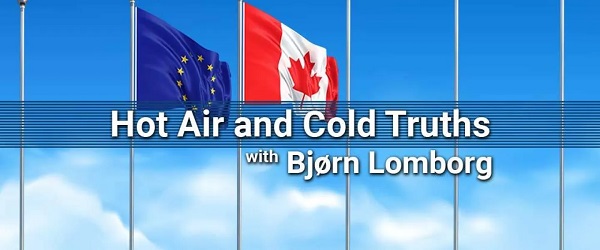Bjorn Lomborg
Despite what activists say, the planet is not on fire

From the Fraser Institute
Nearly half of young Canadians surveyed in a 2022 study said they believed humanity is doomed because of climate change, while more than three-quarters said they were frightened. No wonder. They have grown up bombarded both by footage of natural disasters, not just in Canada but around the world, and by activists’ claims that climate change is making the planet unliveable. But that’s just wrong.
The ubiquity of phone cameras and our ability to instantly communicate mean — the “CNN effect” — that the media can show more weather disasters now than ever before. But that doesn’t mean the disasters are deadlier or costlier.
As we saw in the first article in this series, deaths from climate-related disasters have dropped precipitously. On average in the 1870s five million people a year died from such disasters. A century ago, about half a million people a year did. In the past decade, however, the death toll worldwide was fewer than 10,000 people a year. As global population has more than quintupled, disaster deaths have declined 500-fold. And this dramatic decline is true for all major disaster categories, including floods, flash floods, cold waves and wind disasters, and for rich and poor countries alike. But you never hear about that during disaster reporting.
Floods are the most costly and frequent Canadian disasters. But the common claim that flood costs are rising dramatically ignores the obvious fact that when a flood plain has many more houses on it than decades ago and the houses are worth much more then the same flood will cause a lot more damage. We need to keep these changes in mind and measure costs in proportion to GDP. Even the UN says that’s how to measure whether cities and towns are safer.
Though peer-reviewed analysis for Canada is lacking there is plenty to draw on elsewhere. As so often, the U.S. has the most comprehensive data. It shows that while flood costs have increased in absolute terms, that’s only because more people and property are in harm’s way. In the country’s worst year for flooding, 1913, damage exceeded two per cent of GDP, though the yearly average in that era was 0.5 per cent. Today it’s less than 0.05 per cent of GDP — just a tenth what it was a century ago.
We know adaptation makes disasters much less threatening over time. Consider sea level rise, which threatens to flood coastal zones around the world. A much-cited study shows that at the turn of this century an average of 3.4 million people a year experienced coastal flooding, with $11 billion in annual damages. At the same time, around $13 billion or 0.05 per cent of global GDP was spent on coastal defences.
By the end of this century, more people will be in harm’s way, and climate change could raise sea levels by as much as a metre. If we don’t improve coastal defences, vast areas will be routinely inundated, flooding 187 million people and causing $55 trillion in annual damages, more than five per cent of global GDP in 2100. This finding does routinely make headlines.
But it ignores adaptation, which research shows will cost much less. On average, countries will avoid flood damage by spending just 0.005 per cent of GDP. Even with higher sea levels, far fewer people will be flooded — by 2100 just 15,000 people a year. Even the combined cost of adaptation and damage will be just 0.008 per cent of GDP.
Enormously ambitious emissions-reduction policies costing hundreds of trillions of dollars could cut the number of people flooded at century’s end from that 15,000 number down to about 10,000 per year. But notice the difference: Adaptation reduces the number currently being flooded by almost 3.4 million and avoids another 184 million people being flooded annually by 2100. At best, climate policy can save just 0.005 million.
We often hear that the “world is on fire” because of climate change. New Liberal leader Mark Carney repeated that in his acceptance speech Sunday. And it’s true that in 2023 more of Canada’s surface area burned than in any year since 1970, with climate change probably partly to blame. Even so, two points need to be kept in mind.
First, most studies projecting an increase in wildfires ignore adaptation. In fact, humans don’t like fire and make great efforts to reduce it, which is why since 1900 humanity has seen less burned area, not more. The data from last century involve historical reconstruction but since 1997, NASA satellites have tracked all significant fires. The record shows a dramatic fall in global burned area. Last year it was the second lowest, and in 2022 the lowest ever. And studies find that with adaptation the area burned will keep falling, even without climate action.
Second, reducing emissions is a terribly inefficient way to help. Studies by the U.S. Environmental Protection Agency show that even drastic cuts in emissions would reduce the burned area only slightly this century. Simpler, cheaper, faster policies like better forest management, prescribed fires and cleaning out undergrowth can help much more.
The flood of disaster porn is terrifying our kids and skewing our perception, and that can only lead to bad climate policy.
2025 Federal Election
Don’t double-down on net zero again

From the Fraser Institute
In the preamble to the Paris Agreement, world leaders loftily declared they would keep temperature rises “well below 2°C” and perhaps even under 1.5°C. That was never on the cards—it would have required the world’s economies to effectively come to a grinding halt.
The truth is that the “net zero” green agenda, based on massive subsidies and expensive legislation, will likely cost more than CAD$38 trillion per year across the century, making it utterly unattractive to voters in almost every nation on Earth.
When President Trump withdrew the United States from the Paris Climate Agreement for the first time in 2017, then-Canadian Prime Minister Justin Trudeau was quick to claim the moral high ground, declaring that “we will continue to work with our domestic and international partners to drive progress on one of the greatest challenges we face as a world.”
Trudeau has now been swept from the stage. On his first day back in office, President Trump signed an executive order that again begins the formal, twelve-month-long process of withdrawing the United States from the Paris Agreement.
It will be tempting for Canada to step anew into the void left by the United States. But if the goal is to make effective climate policy, whoever is Canada’s prime minister needs to avoid empty virtue signaling. It would be easy for Canada to declare again that it’ll form a “coalition of the willing” with Europe. The truth is that, just like last time, that approach would do next to nothing for the planet.
Climate summits have generated vast amounts of attention and breathless reporting giving the impression that they are crucial to the planet’s survival. Scratch the surface, and the results are far less impressive. In 2021, the world promised to phase-down coal. Since then, global coal consumption has only gone up. Virtually every summit has promised to cut emissions but they’ve increased almost every single year, and 2024 reached a new high.
Way before the Paris Agreement was inked, the Kyoto Protocol was once sold as a key part of the solution to global warming. Yet studies show it achieved virtually nothing for climate change.
In the preamble to the Paris Agreement, world leaders loftily declared they would keep temperature rises “well below 2°C” and perhaps even under 1.5°C. That was never on the cards—it would have required the world’s economies to effectively come to a grinding halt.
The truth is that the “net zero” green agenda, based on massive subsidies and expensive legislation, will likely cost more than CAD$38 trillion per year across the century, making it utterly unattractive to voters in almost every nation on Earth.
The awkward reality is that emissions from Canada, the EU, and other countries pursuing climate policies matter little in the 21st century. Canada likely only makes up about 1.5 per cent of the world’s emissions. Add together Canada’s output with that of every single country of the rich-world OECD, and this only makes up about one-fifth of global emissions this century, using the United Nations’ ‘middle of the road’ forecast. The other four-fifths of emissions come mostly from China, India and Africa.
Even if wealthy countries like Canada impoverish themselves, the result is tiny — run the UN’s standard climate model with and without Canada going net-zero in 2050, and the difference is immeasurable even in 2100. Moreover, much of the production and emissions just move to the Global South—and even less is achieved.

One good example of this is the United Kingdom, which—like Prime Minister Trudeau once did—has leaned into climate policies, suggesting it would lead the efforts for strong climate agreements. British families are paying a heavy price for their government going farther than almost any other in pursuing the climate agenda: just the inflation-adjusted electricity price, weighted across households and industry, has tripled from 2003 to 2023, mostly because of climate policies. This need not have been so: the US electricity price has remained almost unchanged over the same period.
The effect on families is devastating. Had prices stayed at 2003 levels, an average family-of-four would now be spending CAD$3,380 on electricity—which includes indirect industry costs. Instead, it now pays $9,740 per year.
Rising electricity costs make investment less attractive: European businesses pay triple US electricity costs, and nearly two-thirds of European companies say energy prices are now a major impediment to investment.
The Paris Treaty approach is fundamentally flawed. Carbon emissions continue to grow because cheap, reliable power, mostly from fossil fuels, drives economic growth. Wealthy countries like Canada, the US, and European Union members have started to cut emissions—often by shifting production elsewhere—but the rest of the world remains focused on eradicating poverty.
Poor countries will rightly reject making carbon cuts unless there is a huge flow of “climate aid” from rich nations, and want trillions of US dollars per year. That won’t happen. The new US government will not pay, and the other rich countries cannot foot the bill alone.
Without these huge transfers of wealth, China, India and many other developing countries will disavow expensive climate policies, too. This potentially leaves a rag-tag group led by a few Western European progressive nations, which can scarcely afford their own policies and have no ability to pay off everyone else.
When the United States withdrew from the Paris Agreement in 2017, Canada’s doubling down on the Paris Treaty sent the signal that it would be worthwhile spending hundreds of trillions of dollars to make no real difference to temperatures. We fool ourselves if we pretend that doing so for a second time will help the planet.
We need to realize that fixing climate change isn’t about sanctimonious summits, lofty speeches, and bluster. In coming weeks I’ll outline the case for efficient policies like innovation, adaptation and prosperity.
Bjorn Lomborg
The stupidity of Net Zero | Bjorn Lomborg on how climate alarmism leads to economic crisis

From spiked on YouTube
Note: This interview is focused on Europe and the UK. It very much applies to Canada. The 2025 Federal Election which will see Canadians choose between a more common sense approach, and spending the next 4 years continuing down the path of pursuing “The Stupidity of Net Zero”.
European industry is in freefall, and Net Zero is to blame.
Here, climate economist Bjorn Lomborg – author of Best Things First and False Alarm – explains how panic over climate change is doing far more damage than climate change itself. Swapping cheap and dependable fossil fuels for unreliable and expensive renewables costs our economies trillions, but for little environmental gain, Lomborg says.
Plus, he tackles the myth of the ‘climate apocalypse’ and explains why there are more polar bears than ever.
Support spiked: https://www.spiked-online.com/support/
Sign up to spiked’s newsletters: https://www.spiked-online.com/newslet…
-

 2025 Federal Election2 days ago
2025 Federal Election2 days agoConservative Party urges investigation into Carney plan to spend $1 billion on heat pumps
-

 Health2 days ago
Health2 days agoExpert Medical Record Reviews Of The Two Girls In Texas Who Purportedly Died of Measles
-

 2025 Federal Election2 days ago
2025 Federal Election2 days agoCorporate Media Isn’t Reporting on Foreign Interference—It’s Covering for It
-

 2025 Federal Election2 days ago
2025 Federal Election2 days agoMark Carney To Ban Free Speech if Elected
-

 MAiD2 days ago
MAiD2 days agoDisability rights panel calls out Canada, US states pushing euthanasia on sick patients
-

 2025 Federal Election2 days ago
2025 Federal Election2 days agoPoilievre will make it harder for politicians to boost their portfolios, close Carney loopholes
-

 2025 Federal Election1 day ago
2025 Federal Election1 day agoPPE Videos, CCP Letters Reveal Pandemic Coordination with Liberal Riding Boss and Former JCCC Leader—While Carney Denies Significant Meeting In Campaign
-

 2025 Federal Election24 hours ago
2025 Federal Election24 hours agoNo Matter The Winner – My Canada Is Gone









